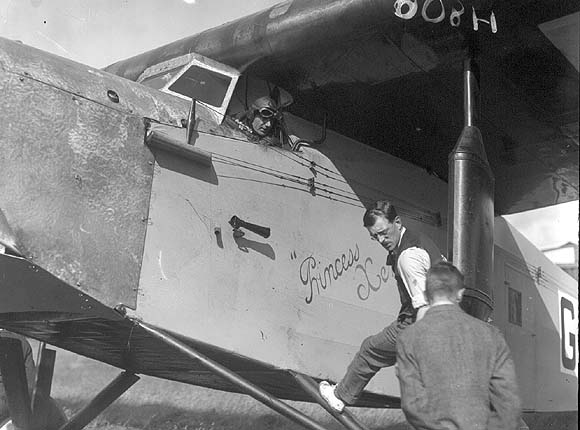Robert Henry McIntosh
<templatestyles src="Module:Infobox/styles.css"></templatestyles>
Robert Henry McIntosh | |
|---|---|
 | |
| Born | 23 September 1894 |
| Died | 1983 |

Robert Henry McIntosh (23 September 1894–1983), also known as All-Weather Mac following his ability to land safely in a six passenger Handley Page 0/400 in dense fog at Croydon Airport in October 1921, was a British wing commander and one of Imperial Airways' 16 original pilots.[1][2] In 1927, he made unsuccessful attempts to fly at first across the Atlantic with James Fitzmaurice and then to fly to India and back with Bert Hinkler, both on the aircraft Princess Xenia, a Dutch Fokker F.VIIa.[3][4][5]
A road, McIntosh Close, in Roundshaw, London Borough of Sutton, is named after him.[6]
Career
McIntosh served with the Merchant Navy before the First World War. When war broke out he joined the British Army, serving as a despatch rider before joining the Royal Flying Corps and learning to fly. In October 1918, he joined No. 214 Squadron RAF, equipped with the Handley Page O/400 heavy bomber. In September 1919 he left the RAF to join the airline Handley Page Transport, flying commercial scheduled services to Europe from Handley Page Transport's base at Cricklewood Aerodrome.[7]
References
- Lua error: bad argument #1 to "get" (not a valid title).
- Lua error: bad argument #1 to "get" (not a valid title).
<templatestyles src="Module:Article stub box/styles.css"></templatestyles>
- ↑ Lua error: bad argument #1 to "get" (not a valid title).
- ↑ Lua error: bad argument #1 to "get" (not a valid title).
- ↑ The Adventures of Flying Fitz. Derek O'Connor. (30 October 2014) Retrieved 20 August 2020 from HistoryNet
- ↑ Lua error: bad argument #1 to "get" (not a valid title).
- ↑ Name McIntosh, Robert Henry Date of Birth: 23 September 1894. (1918–1919) National Archives. Retrieved 28 June 2022 from link
- ↑ Lua error: bad argument #1 to "get" (not a valid title).
- ↑ Lang Aeroplane September 1999, p. 36.
- Pages with script errors
- Use dmy dates from June 2022
- Articles with invalid date parameter in template
- EngvarB from June 2022
- Articles with hCards
- Articles having different image on Wikidata and Wikipedia
- 1894 births
- 1983 deaths
- British aviators
- Croydon Airport
- Imperial Airways
- All stub articles
- Aviation biography stubs
